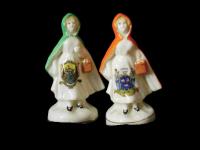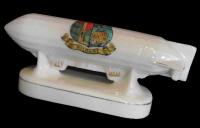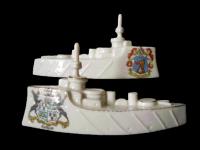Thanks for the memory: Irish crest ware souvenirs
Published in 20th-century / Contemporary History, Features, Issue 3 (May/June 2012), Volume 20
When the figures of Red Riding Hood were offered to dealers, Dublin retained the red cloak but Cork went green.
As souvenirs, the greatest quantities of crest ware or Goss ware (after the main manufacturer, Adolphus Goss) bear the names and heraldic crests of major cities or well-known seaside resorts. The market developed with the advance of railways, and especially leisure time for workers, and the notion of holidays. Thus Irish crest ware is rarer than English or Scottish, reflecting the limited areas of tourism and the money available for non-essentials. Irish crest ware also reflects interesting aspects of our history, such as the change of some names after 1921—Maryborough into Portlaoise, or Kingstown into Dún Laoghaire. There is interest in heraldic town and royal coats of arms and crests. Tullamore, without an ancient crest to call its own, created one using the icons of wolfhound, round tower and harp, while Fermoy and Lismore commissioned pieces bearing the crest of the dominant landlord family. Unionists in Bray could have miniature cups with a crown wreathed in shamrocks. And when the figure of Red Riding Hood was offered to dealers, Dublin retained the red cloak but Cork went green. The First World War stimulated sales, with new miniatures such as battleships, bombs and tanks. Former garrison towns and military bases provided a large customer base, as Mrs O’Connor found in her china rooms in Kildare.

The First World War stimulated sales of new miniatures, such as these battleships for Antrim and Tipperary, and a Zeppelin for Kildare.
‘Matching’ is a term given to a bust, device or monument that matches the crest location, like a round tower for Glendalough. Some links will always be a mystery. Why Monaghan on a bust of General John French, viceroy 1918–21 (he claimed links with Roscommon)? The variety of shapes is amazing, usually vases or jugs but also sewing machines, cameras, caricatures, pots and pans, dogs, ducks, lions and footballs. Manufactured mainly in the Potteries district of Staffordshire, local sellers would order shapes through catalogues or travelling salesmen. The manufacturer would trace the coat of arms, or accept a seller’s device. Goss was most particular about accuracy and you couldn’t buy a piece of his crest ware unless you went to the place represented by that crest. The largest quantity of Irish crest ware comes from east Ulster, but Dublin, Cork and Killarney occur regularly. Midland towns are very hard to find, and items from Longford, Roscommon, Cavan and Leitrim rarer still.

Battleships for Antrim and Tipperary
Disruption of trade during the 1920s, dislocation of travel and tourism and the departure of British garrisons took their commercial toll. By the mid-1930s crest ware had had its day as holiday souvenirs and, like John Redmond with the harp of Ireland under him, it came to look old-fashioned and from a world gone by. HI
John Stocks Powell is the retired librarian of York Minster Library and has written extensively on the history of Portarlington.
















